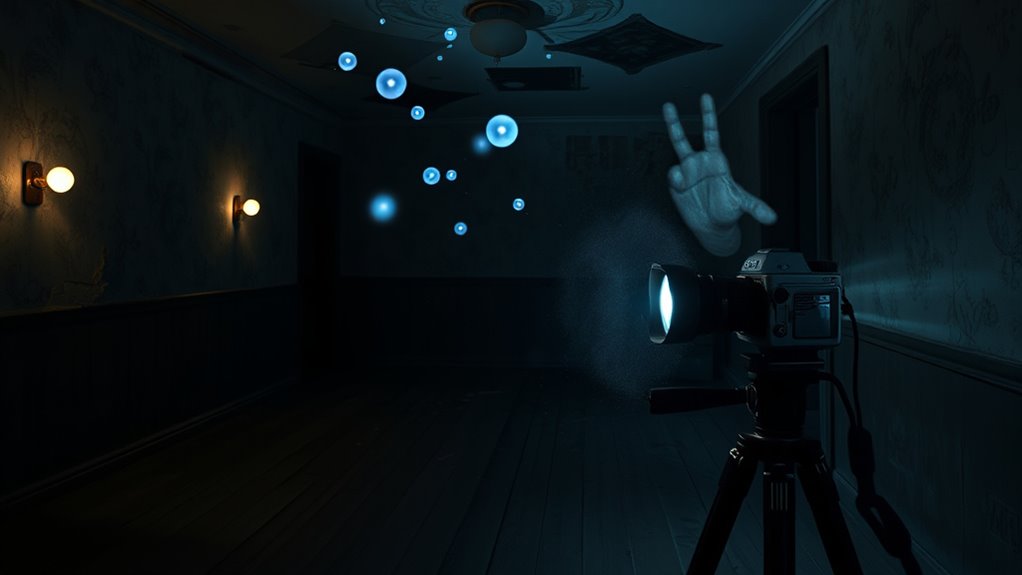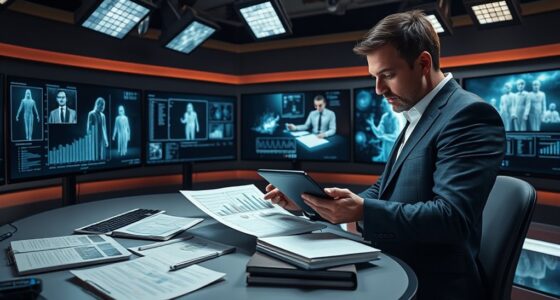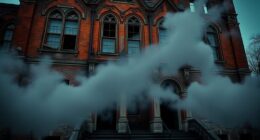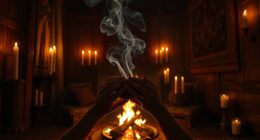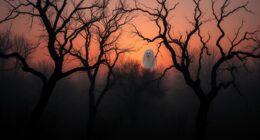To film a ghost hunt effectively, start by selecting haunted locations with rich history and local legends to boost authenticity. Use specialized equipment like EMF meters, infrared cameras, and digital recorders to detect paranormal activity. Create a tense atmosphere with eerie lighting, flickering candles, and unsettling sound effects. Carefully balance suspense and realism, integrating sound design and visual cues. If you keep exploring, you’ll discover how to elevate your ghost hunt footage even further.
Key Takeaways
- Select haunted locations with rich history and legends to enhance authenticity and atmospheric tension.
- Use specialized equipment like EMF meters and infrared cameras to detect paranormal activity effectively.
- Incorporate strategic lighting, sound effects, and silence to build suspense and deepen immersion.
- Balance authentic reactions with creative storytelling to maintain credibility while engaging viewers.
- Conduct thorough safety assessments and post-production enhancements to ensure quality and viewer trust.
Selecting Haunted Locations for Film Shoots
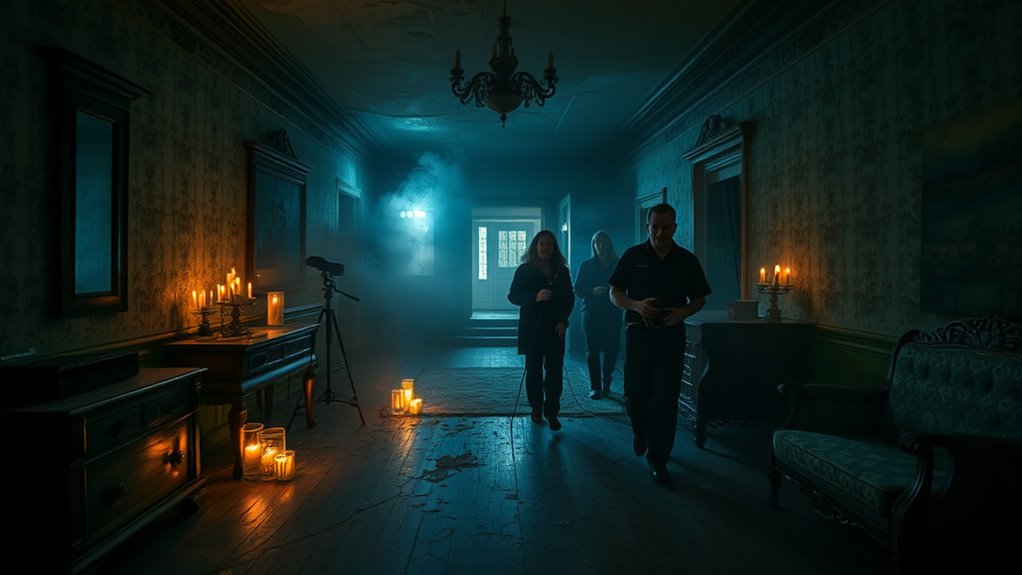
Selecting the right haunted location is essential for creating an authentic and enthralling ghost hunt film. You want a site with rich historical significance that adds depth to your story, making viewers feel immersed in the past. Research local legends and ghost stories associated with potential locations; these tales can inspire scenes and lend credibility to your footage. A place with a well-known haunted reputation naturally attracts curiosity and enhances the spooky atmosphere you aim to capture. Consider how the history and legends intertwine, creating a compelling backdrop for your film. By choosing a location rooted in authentic ghostly lore, you increase both the visual interest and emotional impact of your production, making your ghost hunt film more convincing and engaging. Incorporating spiritual decor elements can further amplify the ambiance and reinforce the supernatural vibe of your setting. Additionally, selecting a location with rich nutritional history can subtly influence the ambiance and authenticity of your shoot, adding an extra layer of depth to your project. Exploring sites with historic significance can also provide unique lighting opportunities and atmospheric effects that heighten the eerie mood. Incorporating elements of mindfulness in your preparation can also help maintain focus and creativity during the filming process. Understanding the vetted nature of your location ensures safety and authenticity, which are crucial for a successful shoot.
Essential Equipment for Capturing the Unseen

To effectively capture paranormal activity on film, having the right equipment is essential. Your tools can reveal unseen energies and spiritual symbolism often missed by the naked eye. Essential gear includes EMF meters, digital recorders, and infrared cameras, crucial for thorough paranormal research. These devices help detect fluctuations and anomalies that suggest ghostly presence. Additionally, understanding the AI vulnerabilities involved in analyzing digital recordings can enhance the accuracy of your findings.
Crafting a Narrative That Builds Suspense
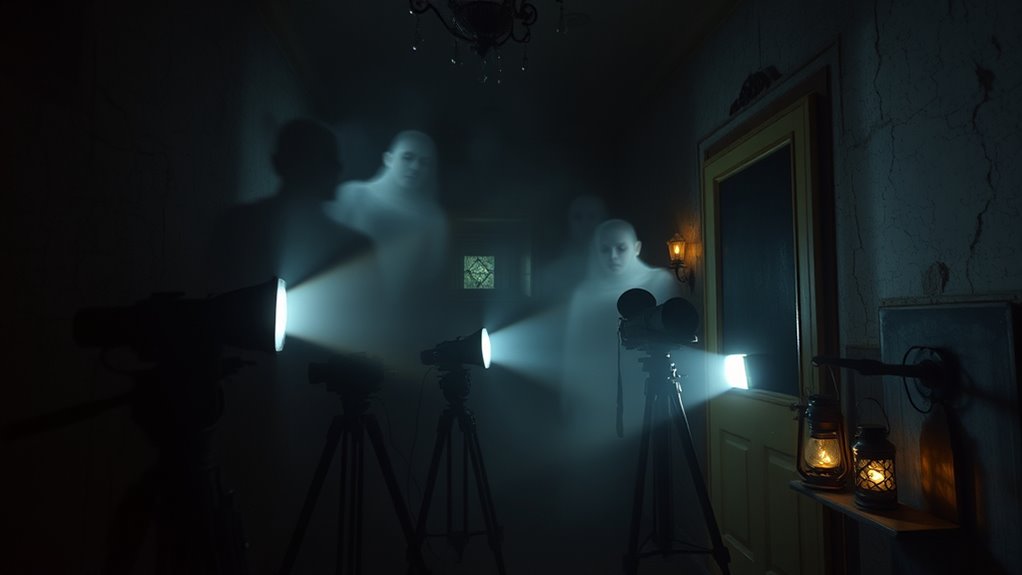
To build suspense, you need to master pacing and timing, knowing when to accelerate or slow down the story. Using silence strategically can heighten tension, making viewers anticipate what’s next. When you combine these techniques, your narrative keeps audiences on the edge of their seats. Paying attention to seasonal variations can also influence the atmosphere and mood of your scenes, enhancing the overall suspense. Incorporating lighting techniques can further manipulate the scene’s tone and keep viewers engaged throughout the story. Additionally, understanding the importance of Fokos can provide inspiration for atmospheric settings that evoke mystery and intrigue. Utilizing sound effects and ambient sounds can also significantly amplify the immersive experience and emotional impact of your ghost hunt scenes. Exploring Kia Tuning options can also inspire creative ways to modify your filming environment, adding unique visual elements that heighten the sense of mystery.
Pacing and Timing
Crafting effective pacing and timing in a ghost hunt film is essential for building suspense that keeps viewers on the edge of their seats. You achieve this by carefully coordinating sound synchronization with visual cues to enhance tension. Sudden shifts in sound, like a chilling noise, paired with quick shot durations, create a sense of urgency and unease. Conversely, longer shots slow the pace, allowing viewers to process the environment and anticipate the next scare. Timing your edits to match the rhythm of the scene amplifies suspense, making each reveal more impactful. Mastering shot duration and sound synchronization guarantees your audience remains engaged, balancing moments of quiet with bursts of intensity to craft a compelling, spine-tingling narrative. Additionally, adjusting the contrast ratio helps to deepen shadows and highlight key visual elements, intensifying the eerie atmosphere. Incorporating sound vibrations can further enhance the haunting effect by subtly influencing viewer emotions and perceptions. Employing tuning techniques similar to those used in vehicle modifications can optimize audio-visual harmony, heightening the overall suspenseful experience. Recognizing the importance of visual storytelling ensures that each scene effectively contributes to the narrative’s tension and atmosphere. Further, applying sound design principles inspired by automotive tuning can fine-tune audio elements for maximum emotional impact.
Strategic Use of Silence
Have you ever noticed how moments of complete silence can make a scene more tense and unsettling? Strategic use of silence, through sound manipulation, heightens suspense by creating a stark contrast to previous noise or activity. Silent moments draw viewers in, making them hyper-aware of every background sound, or the eerie absence of it. You can use silence to build anticipation, signaling that something is about to happen. Carefully timing these silent intervals guides the audience’s emotional response, making the next sound or reveal more impactful. Silence becomes a powerful tool in your storytelling arsenal—when timed right, it amplifies fear and mystery. Incorporate well-placed silent moments to craft a narrative that keeps viewers on the edge of their seats, craving the next reveal.
The Role of Lighting and Sound in Creating Atmosphere

Lighting sets the mood instantly; it can make a scene feel eerie or safe. Sound design amplifies tension, guiding your emotions and focus. Together, they create an immersive atmosphere that keeps viewers on edge.
Enhancing Mood With Lighting
When you adjust the lighting in a scene, you can instantly influence the viewer’s emotional response and set the overall mood. Shadow play is a powerful tool—you can cast ominous shapes or soft silhouettes to evoke mystery or fear. Using low, dim lighting creates an eerie atmosphere, perfect for ghost-hunting scenes. Additionally, understanding color psychology helps you choose hues that influence feelings; cool blues and greens can evoke calm or unease, while reds and oranges generate excitement or danger. By carefully manipulating shadows and colors, you guide your audience’s emotions without words. This intentional lighting design heightens suspense and immerses viewers in the supernatural experience, making every ghostly encounter more visceral and compelling.
Sound Design for Tension
Sound design amplifies the mood created by lighting, turning a scene’s atmosphere into an immersive experience. By layering ambient sounds, you add depth and subtlety that heighten tension. Using soundscaping techniques, you can craft a haunting environment—distant whispers, creaking floors, or unsettling echoes—that keep viewers on edge. Carefully timed sound cues, like a sudden silence or a low rumble, can intensify suspense at key moments. The right combination of ambient layers creates an unpredictable, eerie backdrop that complements the visual atmosphere. When sound and lighting work together, they draw your audience deeper into the ghost hunt, making every flicker of light and every whisper feel more real—and more terrifying. This synergy is essential for building and maintaining a spine-chilling atmosphere.
Techniques for Encouraging Paranormal Activity on Camera

To increase the likelihood of capturing paranormal activity on camera, you need to create an environment that encourages spirits to manifest. Start by setting a quiet, undisturbed space where ghostly whispers can be heard clearly. Use soft lighting or darkness to heighten the atmosphere, which can help produce eerie shadows that spirits might cast. Encourage your team to remain silent and patient, as spirits often respond to calm energy. Avoid sudden movements or loud noises which can disrupt the environment. Position cameras strategically in areas where you’re most likely to observe ghostly whispers or shadows. Remember, your goal is to foster an environment that feels natural and inviting, increasing the chances of spirits revealing themselves on film.
Managing the Balance Between Authenticity and Entertainment
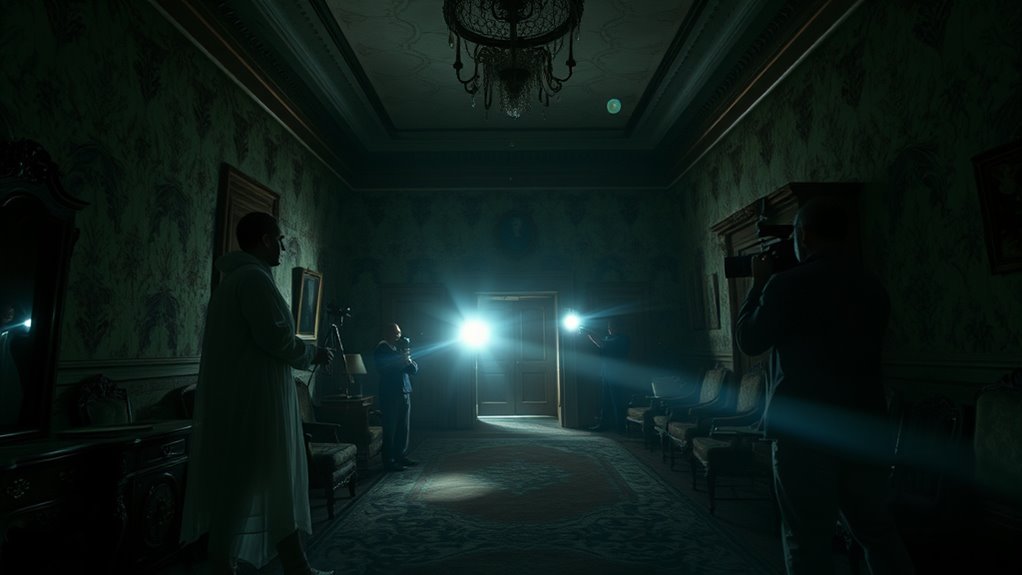
Balancing authenticity with entertainment is essential to maintaining both credibility and viewer engagement in ghost hunt filming. If you focus too much on realism, your audience might find the content dull; if you prioritize entertainment, you risk losing narrative authenticity. To strike the right balance:
Balancing authenticity and entertainment keeps ghost hunt stories credible and captivating.
- Incorporate genuine reactions to build trust and enhance audience engagement.
- Use storytelling techniques that highlight real experiences while adding suspense.
- Be transparent about staged moments to maintain credibility without sacrificing entertainment value.
Challenges and Risks of Filming in Spooky Settings
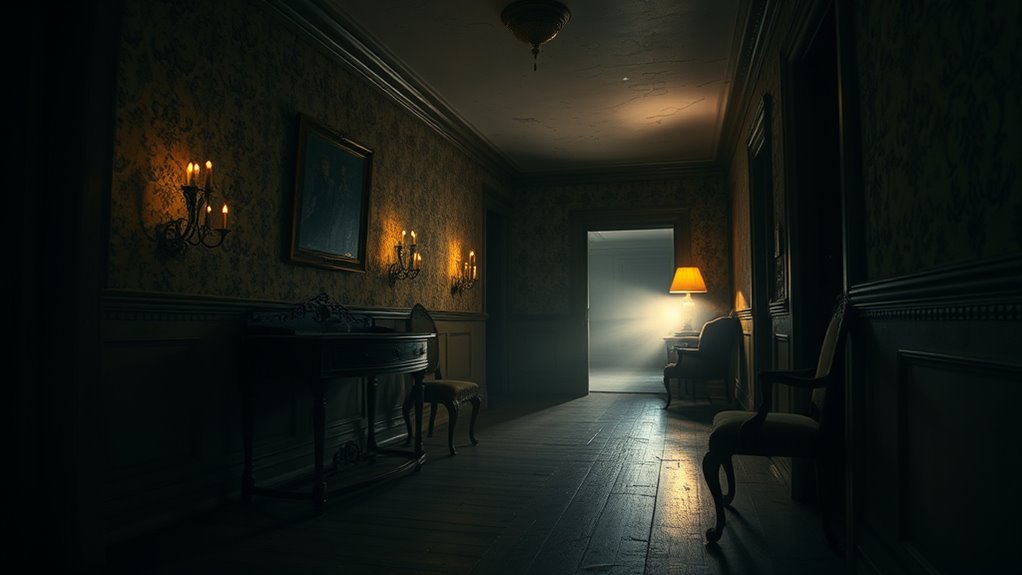
Filming in spooky settings presents unique challenges and risks that can complicate your production. You need to conduct a thorough risk assessment beforehand to identify hazards like unstable structures, uneven terrain, or environmental dangers. Safety should always come first, especially in abandoned buildings or remote locations. Additionally, legal considerations are vital; securing permits, property rights, and insurance protects you from potential liabilities. Ignoring these aspects can result in fines or legal action, halting your shoot. Be prepared for unpredictable conditions such as low visibility or sudden weather changes that could impact crew safety and footage quality. By proactively addressing these risks through careful planning and legal compliance, you ensure a smoother, safer filming experience and maintain the integrity of your ghost hunt adventure.
Post-Production: Enhancing and Analyzing Paranormal Footage

Once you finish filming, the real work begins with enhancing your footage and verifying the evidence. Using advanced video techniques can reveal hidden details or clarify ambiguous images, but it’s essential to ensure your findings are genuine. By applying proper verification methods, you can confidently distinguish real paranormal activity from false positives.
Video Enhancement Techniques
Post-production plays a essential role in revealing the often-hidden details within paranormal footage. You can use various video enhancement techniques to clarify unclear images and identify potential supernatural activity. First, digital stabilization helps smooth shaky footage, making anomalies easier to analyze. Second, color grading adjusts the hues and contrast, highlighting subtle movements or shadows that might otherwise go unnoticed. Third, you can apply noise reduction to clarify low-quality clips. These tools work together to sharpen your footage and bring out key details. When used correctly, they transform shaky or dull recordings into clearer, more compelling evidence. Remember, the goal is to enhance what’s there without adding false information, ensuring your footage remains credible and useful in your ghost hunt investigation.
Evidence Verification Methods
To verify the authenticity of paranormal footage, you need to carefully analyze and enhance the recordings using targeted post-production methods. Start by examining ghostly apparitions frame by frame, looking for inconsistencies or signs of digital manipulation. Use software to clarify blurry sections, making ghostly figures more discernible. For EVP recordings, filter out background noise and analyze the audio for unexplained voices or sounds that coincide with visual anomalies. Cross-reference multiple recordings taken at the same time to verify if phenomena are consistent. Be cautious of artifacts or glitches that could mimic paranormal activity. Authentic evidence should remain stable across different devices and editing processes. These verification methods help distinguish genuine paranormal encounters from false positives or technical errors.
Ethical Considerations in Ghostly Filmmaking

As filmmakers explore the mysterious world of spirits and hauntings, they must also consider the ethical implications of their work. Respecting ghost ethics means prioritizing transparency and honesty with your audience and subjects. You should:
- Obtain clear consent protocols from all involved, including property owners and participants, to avoid exploitation.
- Respect the boundaries of any spirits or entities encountered, avoiding sensationalism or manipulation.
- Minimize harm by ensuring your filming doesn’t disrupt or damage the environment or community.
The Impact of Special Effects and CGI on Ghost Hunt Films

Special effects and CGI have transformed ghost hunt films, allowing you to craft more convincing and immersive supernatural scenes. Digital compositing enables seamless integration of multiple visual elements, making ghostly apparitions feel real. With CGI integration, you can create spooky effects that would be impossible or unsafe to film practically. These tools give you the power to manipulate lighting, shadows, and movement, heightening suspense and fear. Advanced techniques like digital compositing help blend practical effects with computer-generated imagery, resulting in a cohesive supernatural atmosphere. As a filmmaker, leveraging these technologies allows you to push creative boundaries and deliver more compelling ghostly encounters that captivate your audience. Ultimately, special effects and CGI elevate the storytelling, making your ghost hunt film more haunting and memorable.
Frequently Asked Questions
How Do Filmmakers Ensure Safety During Paranormal Filming?
You guarantee safety during paranormal filming by prioritizing equipment safety and crew training. You regularly inspect gear to prevent malfunctions and guarantee everything is secure. You also provide thorough training so your crew knows how to handle equipment properly and respond to emergencies quickly. By maintaining a safe environment and preparing your team, you create a secure filming experience, reducing risks and guaranteeing everyone stays safe while capturing supernatural phenomena.
What Legal Permissions Are Needed for Ghost Hunt Filming?
Did you know that 65% of paranormal investigations face legal challenges? When filming a ghost hunt, you need to obtain legal permits and respect privacy rights to avoid issues. You should acquire permissions from property owners and ensure you’re compliant with local laws. Ignoring these can lead to fines or legal action, so always verify your rights and permissions before capturing any footage.
How Do Actors Prepare for Supernatural Role Portrayals?
To prepare for supernatural role portrayals, you focus on character immersion and emotional preparation. You immerse yourself in the character’s mindset, understanding their background and motivations to bring authenticity. You also tap into your emotions, practicing techniques like meditation or visualization to evoke genuine feelings. This combination helps you deliver a compelling performance, making the supernatural elements believable and engaging for your audience.
Can Real Spirits Influence the Filming Process?
You might wonder if real spirits can influence the filming process. While some believe in spiritual interference, there’s no scientific proof of paranormal influence affecting camera work or actor performances. However, if you’re open to the idea, you might notice unexplained phenomena or feelings that seem to sway the atmosphere on set. Ultimately, whether it’s coincidence or supernatural, trust your instincts and stay grounded during filming.
What Are Common Misconceptions About Paranormal Filming Techniques?
You might think paranormal filming involves mysterious camera tricks or high-tech equipment myths, but that’s not always true. Often, what looks like a ghostly apparition is just lighting illusions or camera quirks, not supernatural activity. People assume special equipment captures spirits effortlessly, yet many effects come from clever angles or editing. Remember, skepticism helps you see through illusions and focus on real evidence rather than exaggerated paranormal claims.
Conclusion
As you step into the world of ghost hunting films, remember that while technology and storytelling can create a chilling experience, the true power lies in your belief. Some say spirits respond to our energy, making filming a genuine encounter possible. Whether you believe or not, the thrill of capturing the unknown keeps us searching for answers—proving that sometimes, the line between fiction and reality is far more blurred than we think.
